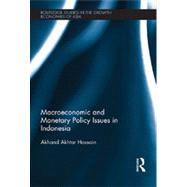- ISBN: 9780415595988 | 0415595983
- Cover: Hardcover
- Copyright: 5/4/2012
Since gaining independence in 1949, Indonesia experienced serious economic and political problems during the 1950s and 1960s. During the Soeharto regime from 1966 to 1998, the Indonesian economy made a steady progress, which was reflected in the steady increase in the country#xE2;#xAC;"s per-capita income level from less than US$100 to about US$1000 by 1996. The economy then suffered a major financial crisis during 1997-1998. By 2000 the economy stabilized, however, recovery was slow and painful. In the meantime the Soeharto government lost power. After political instability for a few years, the country has succeeded in establishing a democratic form of government since the early 2000s. In response to the financial crisis of the late 1990s, Indonesia has undertaken a wide range of economic and financial reforms. Although institutional development has been slow, the country has maintained reasonable fiscal and monetary discipline. The latest global financial crisis has not affected the Indonesian economy in a major way. The economy has grown steadily since 2004 at the rate of about 5 percent per annum. Economists have shown increasing interest in the Indonesian economy since the financial crisis of the late 1990s. Until recently, non-availability of long time-series data has been a common problem for empirical research for Indonesia. Time-series data have become available on most macroeconomic variables at least since the early 1970s, and it is now possible to investigate the key economic relations in Indonesia using modern statistical techniques. Drawing on empirical research, this book is a comprehensive empirical study on the key macroeconomic relations and monetary policy issues in Indonesia. In addition to the use of the data from the 1970s, the author adds earlier data from the 1950s to analyze macroeconomic policies and issues in a historical context. Furthermore, statistical and econometric techniques are positioned alongside general empirical results to supplement descriptive discussion on macroeconomic and monetary developments.






